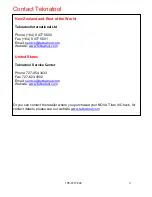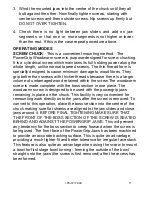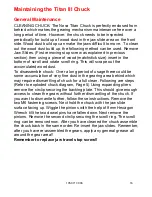
105-0717-006 6
12.
NEVER LEAVE MACHINE RUNNING UNATTENDED.
Do not
leave machine unless it is turned off and has come to a complete
stop.
13.
KEEP GUARDS IN PLACE.
Ensure guards are in working order.
14.
USE CORRECT TOOLS.
Do not use a tool or attachment to do a job
for which it was not designed.
15.
DON’T FORCE THE TOOL.
It will do the job better and be safer at the
rate/force for which it was
designed.
16.
MAINTAIN TOOLS IN TOP CONDITION.
Keep tools sharp and clean
for the best and safest performance. Follow instructions for lubricating
and changing accessories.
17.
NEVER STAND ON THE TOOL.
Serious injury could occur if the tool
is tipped or if the cutting tool is accidentally contacted.
18.
REMOVE ADJUSTING KEYS AND WRENCHES.
Form a habit of
checking to see that keys and adjusting wrenches are removed from
tool before turning it on.
19.
DON’T OVERREACH.
Keep proper footing and balance at all times.
20.
DIRECTION OF FEED.
Feed work into the blade or cutter against the
direction of rotation.
21.
ATTENTION TO WORK.
Concentrate on your work. If you become
tired or frustrated, leave it for awhile and rest.
22.
SECURE WORK.
Use clamps or a vice to hold work when practical.
It’s safer than using your hand and frees both hands to operate tool.
23.
CHECK DAMAGED PARTS.
Before further use of the tool, any part
that is damaged should be carefully checked to ensure that it will
operate properly and perform its intended function. Check for
alignment of moving parts, binding of moving parts, mounting, and any
other conditions that may affect its operation. Any damaged part
should be properly repaired or replaced.
24.
DRUGS, ALCOHOL OR MEDICATION.
Do not operate machine while
under the influence of drugs, alcohol, or any medication.
25.
DUST
WARNING.
The dust generated by certain woods and wood
products can be harmful to your health. Always use an approved dust
mask and operate machinery in well-ventilated areas. In addition,
provide a means for proper dust removal. Use wood dust collection
systems whenever possible.







































